 |
Organic Society
Groups of Friends and Guilds
Plinio Corrêa de Oliveira
We cannot imagine life without friendship. It would be an inhumane humankind.How is friendship between two persons commonly understood? It is a special affinity born from a strong similarity between two individuals or from a complementary need of two persons. Each one senses that the other has understood inner facets of his character and wants to help him develop those points. This understanding only occurs when a great affinity is present.
Such affinity generates a closeness of souls and gives a special satisfaction that comes from finding great similarities in one another. From this similarity arises a mutual esteem, which is what we call friendship.
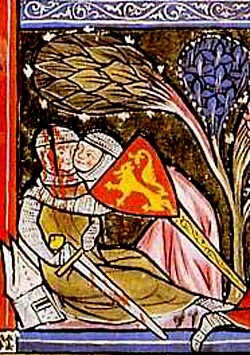
Roland assisting Oliver at his death
in the battlefield |
In History, an example of the highest kind of friendship is what existed between Charlemagne and each of his peers, and among the peers themselves. They had a unity of mission, and therefore complemented each other in the accomplishment of that mission. Each one felt that to execute the work he was called to do, the presence and assistance of the others was indispensable.
On the one hand, there is the complementary role, which we see in the friendship of Roland and Oliver. “Rolland est preux et Olivier est sage” - Roland is courageous and Oliver is wise - is a famous line from The Song of Roland. Roland needed Oliver’s prudence to not expose his life without good reason. Oliver needed Roland’s courage to not be too reasonable and lack heroism. Collaboration envisaged in this way generates complementarities and an esteem that leads to a great union of souls. We know how both Roland and Oliver assisted each other to the death in the battlefield. It represents the complementary role of their missions.
On the other hand, there is the role of similarity. One person sees in the other a companion called to accomplish a similar thing. To the degree that one acknowledges the unique role of the other in realizing that common goal, a great affinity arises. In the case of the peers, Roland and Oliver heroically fought for the expulsion of the Moors from Spain, and to protect their suzerain and Emperor, Charlemagne. They also shared a healthy rivalry in their fidelity to Charlemagne. When two men have this affinity, there is a kind of relationship established between them that reinforces the personality of each.
When one is similar to or complements the other, two persons or groups of persons can come to have a great joy in being together. This joy reflects the profound friendship that exists between them.
The first surge of the instinct of sociability
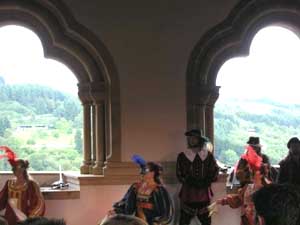
A historic annual festival in Luxemburg |
The instinct of sociability is a characteristic of every human being. Friendship, however, is the excellence of the instinct of sociability. Normally there are just a few persons with whom a man shares this high relationship. When he finds a true friend, he carefully maintains this relation.
Friends seek to be together to enjoy each other’s company, and small groups naturally form. The lives of these small groups of friends are very fecund. Let us imagine, for example, the organic life of one of those minuscule German sovereign States. Anhalt-Zerbst [today a district in Saxony-Anhalt, Germany] is the sonorous name that comes to my mind. I really don’t know much about it, but I think that the whole State of Anhalt-Zerbst is smaller than the city of São Paulo.
So, let’s suppose that the inhabitants of Anhalt-Zerbst assembled into various groups that influence one another. With time, they form increasingly extensive clusters of groups to a point that finally they formed a federation, their own State. This organic development takes place by a kind of osmosis in such a way that the small population of Anhalt-Zerbest constitutes a large-scale friendship.
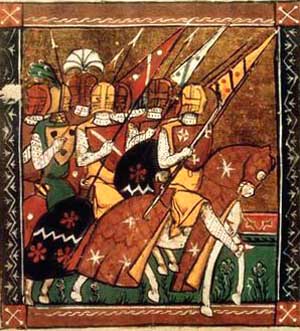
Chivalry gave rise to a friendship based on dedication to a common Catholic ideal |
One of the most efficient ways to produce a general friendship like this is for persons of an area – all the inhabitants together with the nobility – to have fought together against a common enemy. A common dedication to a cause, rather than a commercial interest, is the best way for a general friendship to be established. Then, this common fight is remembered and commemorated every year in a festival with competitions, games and dances, which in its turn helps to strengthen the good relationships.
Let me observe in passing the emptiness of pacifism, which pretends that every battle, rivalry, competition, or emulation is an act of hostility. For the pacifists, friendship is achieved in a syrupy relationship removed from any fight. This is not true. In the common generosity displayed in the fight, the best aspects of friendship emerge.
The natural point of reference around which these groups of friends converge is the noble who lives in the castle. He is their normal leader. He is habitually invited to head the commemorations, judge the games and give the prizes to the winners at the local festivities.
This first surge of the instinct of sociability, with its richness and proper order, is the starting point of an organic society.
The guilds of artisans and workers
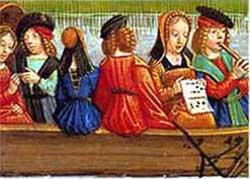
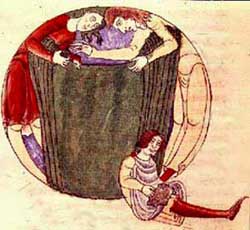
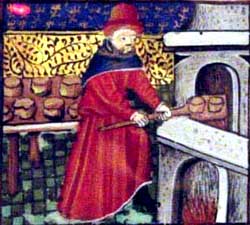
Medieval guild pictures representing musicians, drapers and bakers |
In addition to these groups of friends, there were also associations of artisans and workers. A different type of attraction exists in these institutions. An initial professional interest brings together the members. Then, as a consequence, in the internal life of the guild that develops, friendship has an important role to play.
The coming together of a group of artisans or workers to defend common interests generates per se a sense of class, a companionship turned toward attaining practical advantages for the group. So, here is the guild of the shoemakers in a village that competes for the privilege of receiving a certain number of calf hides each year at a good price so they can make shoes that last longer than those made with old cow hides. In another village, the bakers’ guild negotiates with the municipality to guarantee that its members will have the salt needed for their bread-making, since the town does not have its own salt mine. In another place is a musicians’ guild that enters into talks with the local Bishop to convince him to bring a famous master of polyphonic chant from a distant Benedictine monastery to give them lessons.
These associations, as long as they were inspired by Catholic principles and under the protection of the Church, generated very colorful and healthy relationships in the past. But while this can be the first step of a friendship, it is not friendship properly speaking. It is companionship with the aim of achieving a common interest. This can generate friendship, but it is not an authentic friendship properly speaking.
Friendship burgeons in a guild when some of its members who have developed a friendship outside of the guild, either in the groups we mentioned above or in the family, transport that same way of being – based on a common dedication of similar or complementary souls – to the guild. Then, a guild can become an extended group of friends.
Thus we see that groups of friends, along with the family life, are two main pillars of a Catholic and organic society.

Posted June 12, 2007

  | | Prof. Plinio |
Organic Society was a theme dear to the late Prof. Plinio Corrêa de Oliveira. He addressed this topic on countless occasions during his life - at times in lectures for the formation of his disciples, at times in meetings with friends who gathered to study the social aspects and history of Christendom, at times just in passing.
Atila S. Guimarães selected excerpts of these lectures and conversations from the trancripts of tapes and his own personal notes. He translated and adapted them into articles for the TIA website. In these texts fidelity to the original ideas and words is kept as much as possible.

Related Topics of Interest
 Vocations of the European Peoples Vocations of the European Peoples
 The Role of Admiration and Affection in the Family The Role of Admiration and Affection in the Family
 What is Organic Society? What is Organic Society?
 The Steps of an Organic Relationship The Steps of an Organic Relationship
 Organic Society and Desire of Heaven Organic Society and Desire of Heaven
 The Moon and its Halo The Moon and its Halo
 Departure for the Crusade: A Desire for Sublimity Departure for the Crusade: A Desire for Sublimity
 Nobility and Accessibility: Keys of Catholic Charity Nobility and Accessibility: Keys of Catholic Charity

|
Organic Society | Social-Political | Home | Books | CDs | Search | Contact Us | Donate

© 2002- Tradition in Action, Inc. All Rights Reserved
|
 |
|